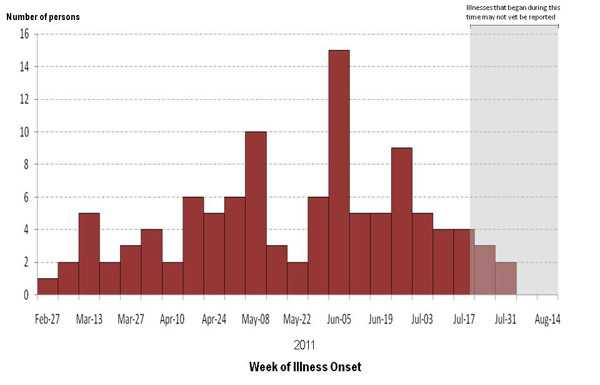Multistate Outbreak of Human Salmonella Heidelberg Infections Linked to Ground Turkey
Persons infected with the outbreak strain of Salmonella Heidelberg, by week of illness onset*

Onset data not currently available for all persons with reported illness.
*n=109 for whom information was reported as of 8/18/2011
Among persons for whom information is available, illnesses began on or after February 27, 2011. Ill persons range in age from less than 1 year to 89 years old, with a median age of 21 years old. Fifty-five percent are male. Among the 73 ill persons with available information, 27 (37%) have been hospitalized. One death has been reported.
The outbreak can be visually described with a chart showing the number of people who became ill each day or week. This chart is called an epi curve. This pattern has been seen before in PulseNet, and in the past typically caused 2-3 cases per month. PulseNet received reports of a small number of cases with the outbreak strain in March 2011, and reported cases increased in mid-May and late June. Illnesses that occurred after July 22, 2011, might not be reported yet due to the time it takes between when a person becomes ill and when the illness is reported. This takes an average of 2 to 3 weeks. Please see the Timeline for Reporting of Salmonella Cases for more details.
Interpretation of Epidemic Curves During an Active Outbreak
The epidemic curve (epi curve) shows progression of an outbreak over time. The epi curve above depicts by week when case patients became ill. The horizontal axis represents the week when a person became ill, also called the week of illness onset. The vertical axis is the number of persons with illness onset each week. The epi curve is updated as new data comes in, and thus is subject to change. The epi curve is complex and incomplete. Several issues are important in understanding it.
- There is an inherent delay between the date that an illness starts, and the date that the case is reported to public health authorities. It typically takes 2-3 weeks for Salmonella infections. That means that someone who got sick last week is very unlikely to have their infection reported to the public health authority, and someone who got sick three weeks ago may just be reported now.
- Some background cases of illness are likely to occur that would have occurred even without an outbreak. This makes it difficult to say exactly which case is the first in an outbreak. Epidemiologists typically focus on the first recognized cluster or group of cases rather than the very first case. Due to the inherent reporting delay, the cluster is sometimes not detected until several weeks after the persons became ill.
- For some cases, the date when they became ill is not known because it takes time before someone from the health department can do an interview to ask for this information. Sometimes the interview never occurs. If the date that the person brought the specimen to be tested to the laboratory is known, we may estimate the date of illness onset as three days before that.
- It can be difficult to determine when cases start to decline because of the reporting delay. This can become clearer as time passes.
- It can be difficult to say when the outbreak is over, because of the reporting delay. The delay means that the curve for the most recent three weeks always looks like the outbreak could be ending even during an active outbreak. The full shape of the curve is only clear after the outbreak is over.
Get email updates
To receive email updates about this page, enter your email address:
Contact Us:
- Centers for Disease Control and Prevention
1600 Clifton Rd
Atlanta, GA 30333 - 800-CDC-INFO
(800-232-4636)
TTY: (888) 232-6348 - Contact CDC–INFO
 ShareCompartir
ShareCompartir


